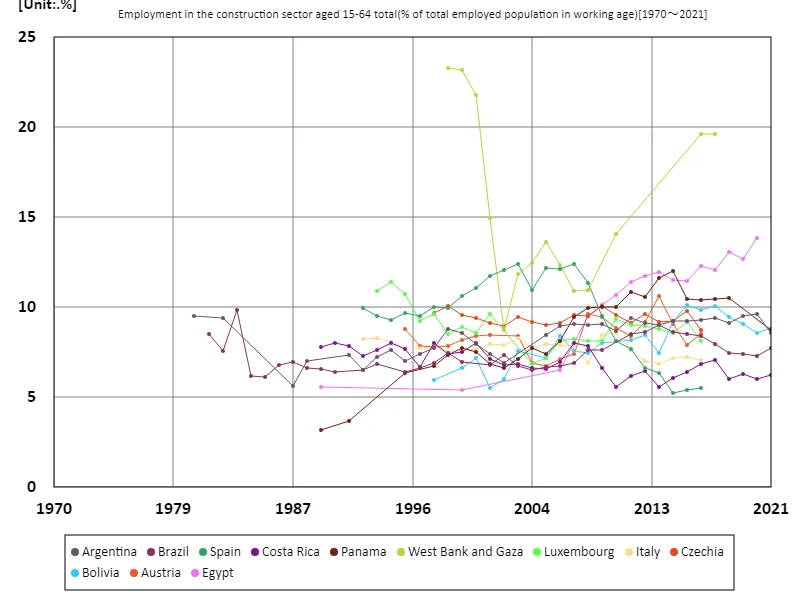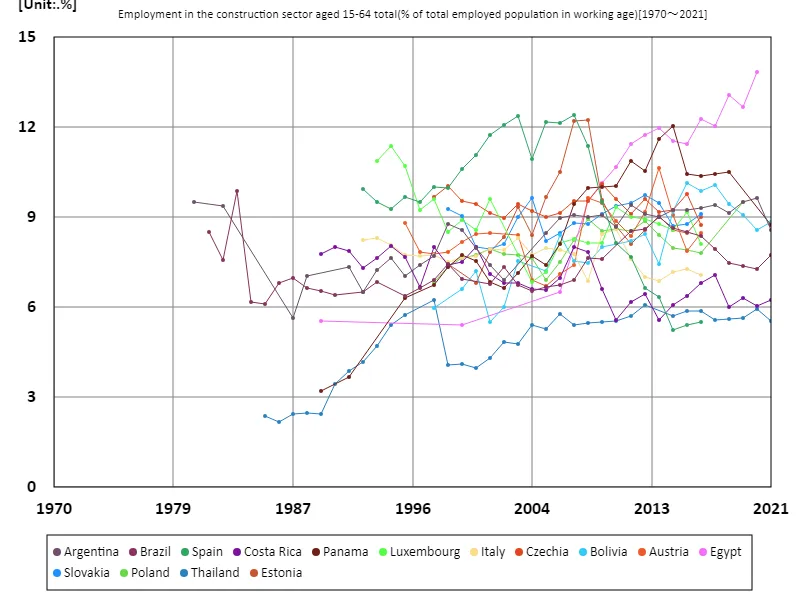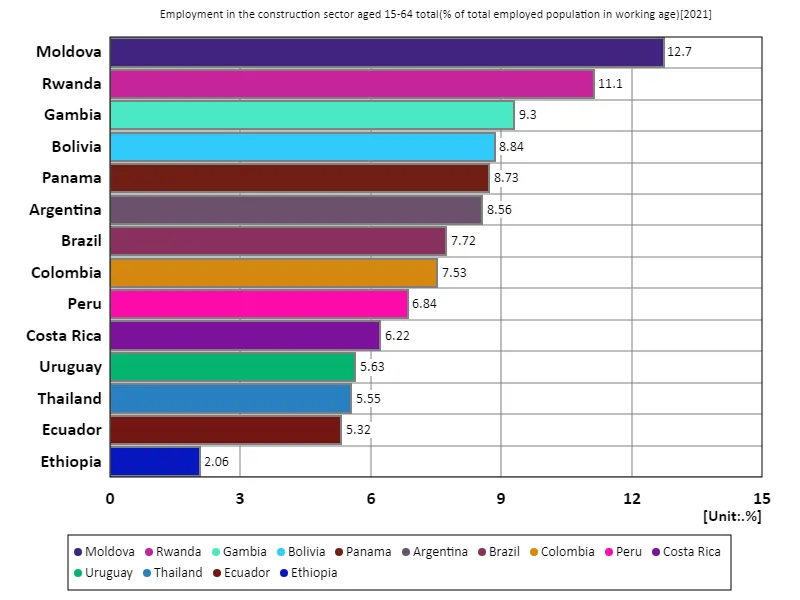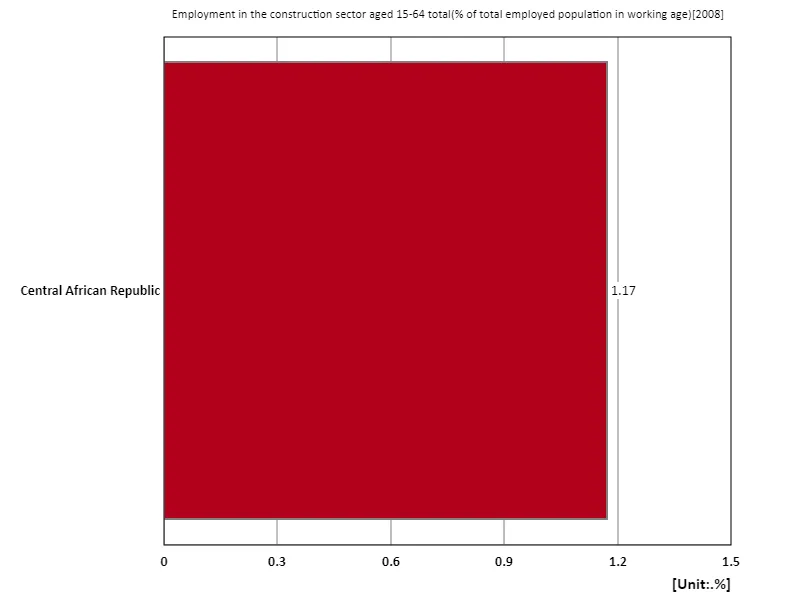- Abstract
- Employment rate in the construction sector for all 15-64 year olds (percentage of working-age population)
- Employment rate in the construction sector for all 15-64 year olds (percentage of working-age employed population) (Worldwide)
- Employment rate in the construction sector for all 15-64 year olds (percentage of working age employed population) (Worldwide, latest year)
- Employment rate in the construction sector for all 15-64 year olds (percentage of working-age employed population) (region, latest year)
- Reference
Abstract
Several factors are behind Bolivia’s high employment rate in the construction sector, at 8.84% in 2021. First, Bolivia is a rapidly growing economy, with rapid urbanization and infrastructure development. This has increased demand in the construction sector, resulting in job growth. Government public works projects and foreign investment also support this trend. Over the past few decades, Bolivia has been diversifying its economy, with growth in the construction sector being particularly notable. In contrast, other countries have lower employment rates in the construction sector, with high rates like those in Bolivia being the exception due to differences in economic maturity and industrial diversity.
Employment rate in the construction sector for all 15-64 year olds (percentage of working-age population)
Employment in the construction sector in the West Bank and Gaza Strip hit a record high of 23.2% in 1998, but has since declined significantly to a current peak of 84.2% due to political instability and economic constraints. The late 1990s saw a boom in the construction sector, driven by rapid infrastructure expansion and urbanization. However, in the 2000s, conflict with Israel and internal political instability caused construction projects to stagnate and resources to become a problem. This has resulted in a noticeable trend towards a decline in employment rates. Fluctuations in economic conditions and local safety have had a direct impact on construction sector employment, resulting in notable changes compared to its peak.


The maximum is 23.2%[1998] of West Bank and Gaza, and the current value is about 84.2%
Employment rate in the construction sector for all 15-64 year olds (percentage of working-age employed population) (Worldwide)
Several economic and social factors are behind Egypt’s construction sector’s high employment rate of 13.8% in 2020. This peak has been underpinned by Egypt’s economic growth, rapid urbanization, and massive investment in infrastructure development. In particular, government public works projects, residential construction, and commercial developments increased employment in the construction sector. Additionally, Egypt is located in a strategic geographical location, and infrastructure development has been progressing to deepen ties with the Middle East and Africa. Meanwhile, employment rates in Egypt’s construction sector have fluctuated over the past decades. During the 1980s and 1990s, employment rates in the construction sector were sluggish due to economic instability and policy changes. However, stabilization and economic reforms since the 2000s, especially large-scale development projects since the 2010s, have helped boost the employment rate. At its peak in 2020, Egypt’s construction sector was a key driver of economic growth, with a pronounced impact on the labor market.


The maximum is the latest one, 13.8% of Egypt
Employment rate in the construction sector for all 15-64 year olds (percentage of working age employed population) (Worldwide, latest year)
According to 2021 data, Moldova has the highest employment rate in the construction sector at 12.7%, well above the overall average of 7.58%. This high figure indicates the strong dependence of Moldova’s economy on the construction sector. Infrastructure development and housing construction have played a key role in Moldova’s economic growth, with the construction sector being a major source of employment. International aid and foreign investment are also helping to drive development in this sector. On the other hand, the total data of 106% suggests that the data across countries is relative and may be influenced by overlaps or different standards. This is because employment rates in the construction sector vary from country to country and the relationship with other industries within a country and the characteristics of the labour market must also be taken into account. Historically, employment rates in the construction sector have fluctuated with economic development, and are particularly susceptible to periods of economic growth and policy changes. The example of Moldova well illustrates the impact of the local economic situation on construction sector employment and provides insights into the country’s economic strategy and development direction.


The maximum is 12.7% of Moldova, the average is 7.58%, and the total is 106%
Employment rate in the construction sector for all 15-64 year olds (percentage of working-age employed population) (region, latest year)
According to the 2008 data, the Central African Republic has the highest employment rate in the construction sector at 1.17%, and the same figures for the average and total mean that this figure is quite representative overall. This figure shows that the construction sector makes up a very small proportion of the overall labour market. Employment in the construction sector is low, especially in developing countries such as the Central African Republic, due to underdeveloped economies and limited infrastructure development. Historically, developing countries have seen a relatively small proportion of employment in the construction sector overall. This is because infrastructure and construction projects are relatively few compared to other sectors of the economy. On the other hand, developed countries have a relatively high employment rate in the construction sector due to their economic growth, urbanization, and infrastructure development. Overall, employment rates in the construction sector depend strongly on the stage of economic development and the progress of infrastructure development.


The maximum is 1.17% of Central African Republic, the average is 1.17%, and the total is 1.17%



Comments